
Wetenschap
De fysisch-chemische aard van colloïdale bewegingsgolven tussen zilvercolloïden
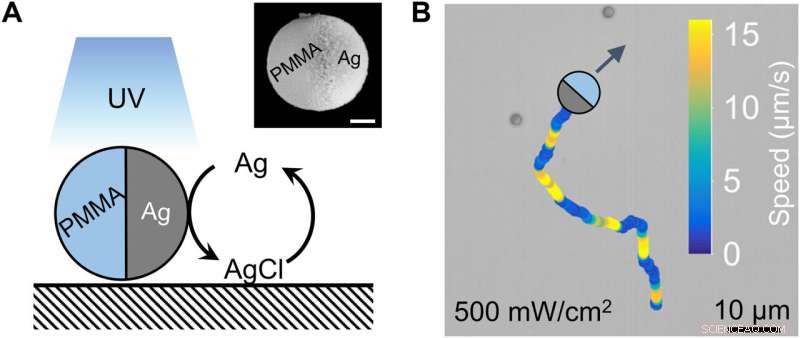
Oscillerende colloïden. (A) Een microbolletje van polymethylmethacrylaat (PMMA) half gecoat met zilver (Ag) ondergaat een oscillerende chemische reactie tussen Ag en AgCl in aanwezigheid van UV-licht, H2O2 en KCl (niet weergegeven). Inzet:scanning-elektronenmicrofoto van de PMMA-Ag Janus-bol; schaalbalk, 0,5 m. (B) een representatief traject van een PMMA-Ag Janus-colloïde die oscilleert tussen afleveringen van snelle en slow motion. De momentane snelheden zijn kleurgecodeerd. Krediet:Wetenschappelijke vooruitgang (2022). DOI:10.1126/sciadv.abn9130
Reizende golven worden vaak waargenomen in biologische en synthetische systemen, en recente ontdekkingen hebben aangetoond hoe zilvercolloïden bewegende bewegingsgolven vormen in waterstofperoxide onder UV-licht. In een nieuw rapport dat nu is gepubliceerd in Science Advances , toonden Xi Chen en een team van onderzoekers op het gebied van slimme materialen, fysica en optica aan het Harbin Institute of Technology en de Shanghai Jiao Tang University in China de colloïdale bewegingsgolf als een heterogeen exciteerbaar systeem.
De zilvercolloïden genereerden reizende chemische golven via reactiediffusie en waren ofwel zelfaangedreven of advecteerd via diffusie of osmose. Het team observeerde de fundamentele resultaten met behulp van hydroxide- en pH-gevoelige kleurstoffen en gebruikte een Rogers-McCulloch-model om de karakteristieke kenmerken van colloïdale golven kwantitatief en kwalitatief te produceren. De resultaten maken de weg vrij om colloïdale golven te integreren als een platform om niet-lineaire fenomenen te bestuderen, en om colloïdaal transport te onderzoeken om informatieoverdracht in biomimetische microrobot-ensembles te onderzoeken.
Biologische oscillatie vertalen in het lab
Oscillerende processen worden algemeen waargenomen in levende systemen, variërend van het circadiane ritme tot cytosolische oscillaties. De koppeling tussen oscillerende eenheden kan leiden tot synchronisatie die aanleiding geeft tot reizende golven, zoals waargenomen met calciumgolven die zich over een bevruchte eicel verspreiden, actiepotentialen die zich voortplanten over kloppende hartcellen, mitotische toestanden en golven van zelforganiserende amoeben. Biofysici proberen de fysisch-chemische aard van deze golven te begrijpen om de onderliggende trends in het leven te onderzoeken. Recente ontdekkingen van de fotochemisch actieve, zilverbevattende oscillerende colloïden zijn een opwindende toevoeging aan de familie van niet-lineaire processen.
Toen onderzoekers een inert polymeer microbolletje, half bedekt met zilver, onderdompelden in een waterige oplossing van waterstofperoxide of kaliumchloride en deze blootstelden aan lichtbronnen, merkten ze de weergave van pulsen op. Ze stelden voor dat de zilveren nanodeeltjes die tijdens het experiment werden geproduceerd, dienden als katalytische hotspots om verdere reacties mogelijk te maken. Ongeacht het chemische detail, merkte het team op hoe diffusie van chemicaliën de Janus-deeltjes voortstuwde via zelf-diffusioforese, om aanleiding te geven tot vergelijkbare colloïdale beweging. In dit werk boden Chen et al een eerste kijk op het genereren van de chemisch actieve colloïden en volgden hun reactie op chemische golven buiten de klassieke reactie-diffusiesystemen. De resultaten bieden sterke mogelijkheden voor translationeel onderzoek dat actieve materie verbindt met niet-lineaire wetenschap om zwermen biomimetische microscopische machines te reguleren.
Het team merkte de ontwikkeling op van periodieke colloïdale bewegingsgolven in gesynchroniseerde voortplanting. Ze hadden eerder ballistische golven geregistreerd bij een gemiddelde bevolkingsdichtheid, waarbij geactiveerde colloïden aan het golffront in alle richtingen bewogen vanwege foretische zelfvoortstuwing. De onderzoekers merkten de opkomst op van kwalitatief verschillende soorten golven, bekend als zwermgolven bij nog hogere bevolkingsdichtheden. In dit geval ontwikkelde het team polymethylmethacrylaatmicrosferen die half bedekt waren met zilver (PMMA-Ag), gesuspendeerd in waterstofperoxide en kaliumchloride en verlicht met 365 nm licht. Het colloïdale deeltje dat zilver bevat zou in principe zwermgolven kunnen uitzenden. De experimentele resultaten gaven een resultaat aan dat vergelijkbaar was met de "Mexicaanse golf" die te zien is in voetbalstadions. Het team kwantificeerde vervolgens de zwermgolf via single-particle tracking en micro-particle beeldsnelheidsmeting door de colloïdale deeltjes als flowtracers te beschouwen. In dit geval reisde de golf met een snelheid van 16 µm/s, met afstembare parameters. Veranderingen in lichtintensiteit veranderden slechts in geringe mate de periode en snelheden van een zwermende golf. The team distinguished the swarming waves from ballistic waves via their characteristic mobility and physicochemistry
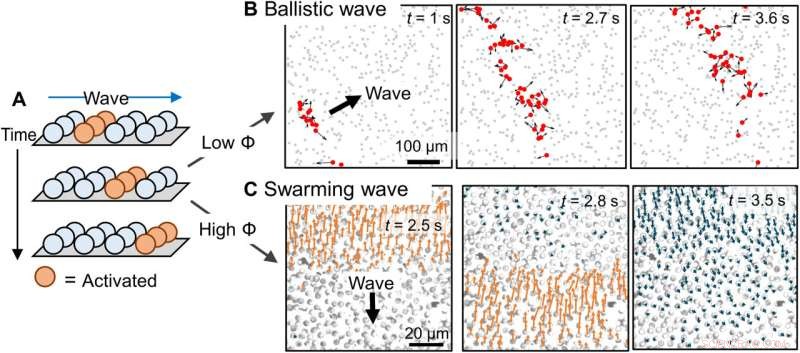
Ballistic and swarming colloidal waves. (A) Schematic diagram of a colloidal motion wave propagating to the right. Each sphere is half-coated with Ag that is not drawn. (B) Ballistic wave propagating across a population of PMMA-Ag colloids. Activated colloids are marked with red dots and their velocities are labeled with arrows. ϕ =1.3%. This figure came from figure 1D in (27). Copyright 2021, Royal Society of Chemistry. (C) Swarming wave propagating downward. Particle velocities are labeled with arrows, so that those moving toward an incoming wave are in orange and those trailing a wave are in dark blue. ϕ =29%. Krediet:Wetenschappelijke vooruitgang (2022). DOI:10.1126/sciadv.abn9130
Chemical waves:The physicochemical nature of a colloidal wave
Chen et al described the physicochemical nature of the activation and recovery of colloidal waves. Since the wave phenomenon is inspired by traveling waves in reaction-diffusion systems, they hypothesized colloidal waves to be underpinned by a traveling chemical wave, due to reaction-diffusion mechanisms. For instance, hydrogen peroxide can decompose faster in higher pH to form a burst of highly oxidative intermediates that oxidized silver into silver chloride. The resulting chemical reactivity activated the silver-colloid to release a burst of chemicals to maintain chemical wave propagation. They confirmed the production of hydroxide anions during silver oxidation, and the formation of hydrogen cations during silver chloride photodecomposition, at and behind the chemical wavefront by using fluorescence mapping and pH measurements.
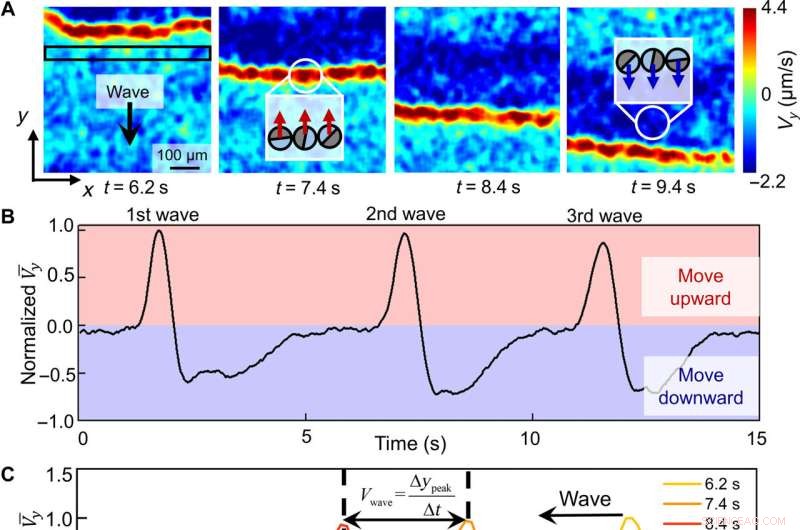
Quantitative characterization of a swarming wave. (A) Micro-PIV–generated flow velocities along the y direction (Vy) of a population of PMMA-Ag particles during the downward propagation of a wave. Positive (upward) velocities are colored red and negative velocities are colored blue. Cartoons in the insets represent how colloids move at or after a wavefront. (B) Normalized Vy averaged across the rectangular box labeled in (A) during the downward propagation of three consecutive waves. Wave periods are calculated by finding the time differences between the peaks. (C) Normalized flow velocities averaged over x at four different time instances labeled in (A) as one wave propagates along y. Wave speed, Vwave, is calculated by dividing the distance the wavefront travels along y (∆ypeak) by the time interval ∆t. (D) Wave periods and speeds under different light intensities. (E) Wave speeds at different population densities ϕ. (F) Particle speeds at different population densities. Error bars represent SDs from three measurements; 0.5 wt % H2O2 and 200 μM KCl were used in all experiments in this figure. Krediet:Wetenschappelijke vooruitgang (2022). DOI:10.1126/sciadv.abn9130
Colloids respond to a chemical wave:Modeling a reaction-diffusion colloidal wave
The scientists next studied the dynamics of colloidal particles in a chemical wave to dictate the type of colloidal wave formed. They noted ionic self-diffusiophoresis, and at higher ionic densities they noted weaker electro-kinetic effects for reduced self-propulsion. They identified the dynamics of neutral diffusio-osmosis dynamics, which moved colloid particles via advection, in addition to self-propagation. As self-propagation weakened and diffusio-osmosis intensified in a crowded solution with rising ionic strength, the colloidal wave switched to swarming wave. The team observed a range of effects, including electrokinetic effects, advection support via osmosis, and self-propulsion during the experiments. Chen et al next reproduced and corroborated the proposed reaction-diffusion colloidal wave via numerical simulations. At the first step, they used the Rogers-McCulloch model to simulate a chemical wave, the resulting numerical models qualitatively reproduced key features, to explore the dynamics of colloidal waves.
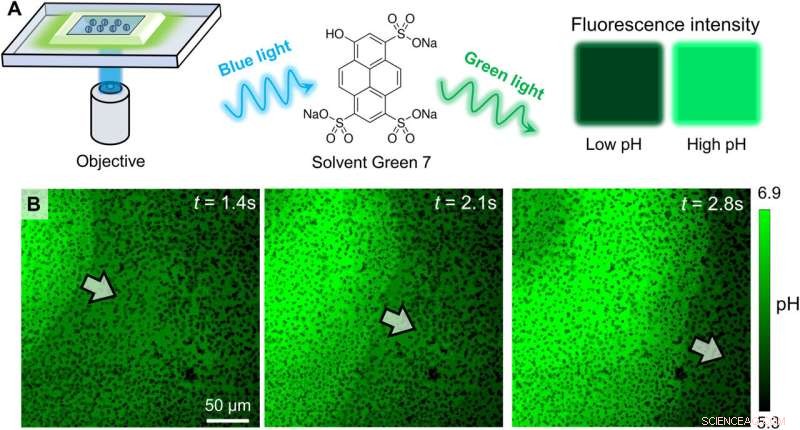
Experimental confirmation of an OH− wave. (A) Schematic diagram of the experimental setup for relating the fluorescence emission of Solvent Green 7 with local pH. (B) Optical micrographs of the pH profile during the propagation of a colloidal wave. PMMA-Ag particles of a population density ϕ of 25% were suspended in an aqueous solution containing 0.5 wt % H2O2, 200 μM KCl, and 100 μM Solvent Green 7. A blue light source (475 nm, 75 mW/cm2) served both to activate the oscillatory reaction and to excite the dye molecules. Krediet:Wetenschappelijke vooruitgang (2022). DOI:10.1126/sciadv.abn9130
Qualitative comparison of colloidal waves between experiments (left) and simulations (right). (A to D) Evolution of target waves (A and B) and spiral waves (C and D). (E and F) The annihilation of two colloidal waves traveling in opposite directions. (G and H) Two consecutive waves. In all experiments, PMMA-Ag particles [population density ϕ of 20% for (B), 15% for (D), 20% for (F), and 23% for (H)] were suspended in an aqueous solution containing 0.5 wt % H2O2 and 200 μM KCl under a 405-nm illumination of 1.6 W/cm2. Krediet:Wetenschappelijke vooruitgang (2022). DOI:10.1126/sciadv.abn9130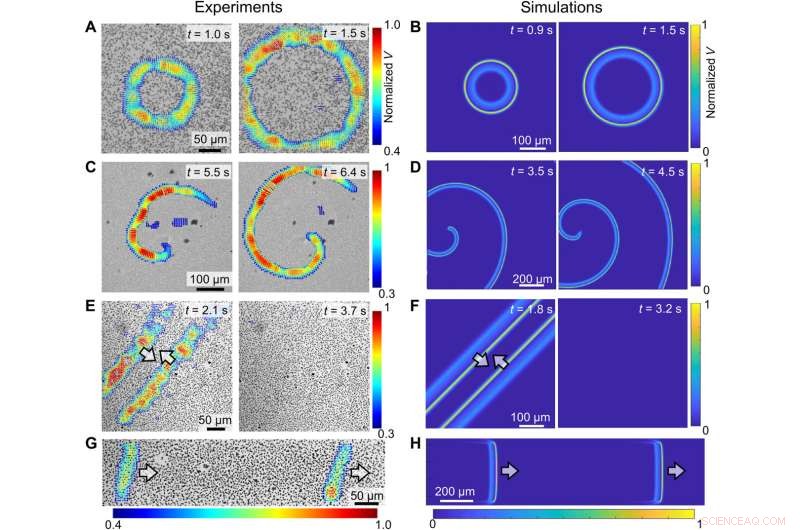
In this way, Xi Chen and colleagues developed a numerical model to simulate colloidal waves to study the heterogeneity of chemical waves. The outcomes showed good agreement with simulations and experiments to provide key insights to understand microscopic details of chemical waves in experimental systems. Colloidal waves can be integrated with optical tweezers, acoustofluidics or microfluidics to regulate micro- and nanoscopic objects in space and time. The method is useful to swarm physicochemical dynamics of a colloidal wave and can lead to develop wave-mediated information transmission systems to examine autonomous micro-robots. The colloidal waves present a good model system of reaction-diffusion processes at mesoscopic and microscopic scales. + Verder verkennen
Axisymmetric 'spike waves' far exceed limits previously thought to dictate maximum height of ocean waves
© 2022 Science X Network
 Collectieve ontvlechting van verstrengelde polymeren
Collectieve ontvlechting van verstrengelde polymeren Wat is het verschil tussen zuivere stoffen en mengsels?
Wat is het verschil tussen zuivere stoffen en mengsels?  Onderzoekers ontdekken C-H-bindingsactiveringsreacties bij lage temperatuur door foto-geïnduceerde middelen
Onderzoekers ontdekken C-H-bindingsactiveringsreacties bij lage temperatuur door foto-geïnduceerde middelen CO2-uitstoot opruimen kan miljoenen waard zijn
CO2-uitstoot opruimen kan miljoenen waard zijn Karakteriseringsstrategie helpt bij het scheiden van metaal met een hoge zuiverheid
Karakteriseringsstrategie helpt bij het scheiden van metaal met een hoge zuiverheid
 Bosbranden zorgen voor uitbreiding van savannes in het hart van de Amazone
Bosbranden zorgen voor uitbreiding van savannes in het hart van de Amazone Hoe koolstoflandbouw de klimaatverandering kan helpen oplossen
Hoe koolstoflandbouw de klimaatverandering kan helpen oplossen Waterwaarschuwing naarmate klimaatrisico's toenemen:rapport
Waterwaarschuwing naarmate klimaatrisico's toenemen:rapport Studie bevestigt bliksem krachtiger over oceaan dan over land
Studie bevestigt bliksem krachtiger over oceaan dan over land Individuele actie zal niet leiden tot een opwarming van 1,5 ° C - sociale verandering is nodig, zoals de geschiedenis laat zien
Individuele actie zal niet leiden tot een opwarming van 1,5 ° C - sociale verandering is nodig, zoals de geschiedenis laat zien
Hoofdlijnen
- Virtuele kusten verbeteren het begrip van mogelijke uitkomsten van kustplanning
- Naburige celtypes beïnvloeden de variabiliteit van genexpressie in één cel
- De bergleeuw in de wijk San Francisco is verdoofd
- Een model van een plantencel in een plastic zak maken
- Het menselijk brein is bedraad voor poëzie
- Animatie ontmoet biologie - werpt nieuw licht op het gedrag van dieren
- Nieuwe aanwijzing gevonden in buitenaardse goudvis suggereert dat het mogelijk een weekdier was
- Aan vuur aangepaste insecten maken optimaal gebruik van door bosbranden gesteriliseerde broedplaatsen
- De bodemtemperatuur kan de verspreiding van plagen in gewassen voorspellen
- Hoe GPM uit differentiële druk te berekenen
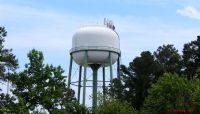
- Wetenschappers ontrafelen 70 jaar oud mysterie over hoe magnetische golven de zon verwarmen
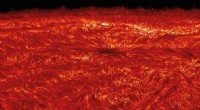
- Spin-opruimingsmethode brengt praktische kwantumcomputers dichter bij de realiteit
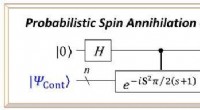
- Sneeuwbalkamer helpt onderzoekers onderkoeld water te gebruiken om donkere materie te zoeken
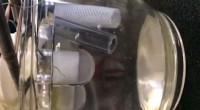
- Elektrische polarisatie in de macroscopische wereld en elektronen die op atomaire schaal bewegen
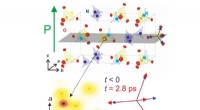
 Anemische ster draagt het merkteken van zijn oude voorouder
Anemische ster draagt het merkteken van zijn oude voorouder Mechanische ingenieurs ontwikkelen manieren om de productiviteit van windmolenparken te verbeteren
Mechanische ingenieurs ontwikkelen manieren om de productiviteit van windmolenparken te verbeteren Onderzoek:toegenomen gebruik van videoconferentie-apps tijdens pandemie leidde tot meer vermoeidheid onder werknemers
Onderzoek:toegenomen gebruik van videoconferentie-apps tijdens pandemie leidde tot meer vermoeidheid onder werknemers Aziatische steden worden geconfronteerd met een perfecte storm van milieugevaren
Aziatische steden worden geconfronteerd met een perfecte storm van milieugevaren General Motors zegt dat de staking heeft geleid tot een verlies van $ 194 miljoen in het vierde kwartaal
General Motors zegt dat de staking heeft geleid tot een verlies van $ 194 miljoen in het vierde kwartaal Onderzoekers ontwikkelen adaptieve transistor op nanometerschaal
Onderzoekers ontwikkelen adaptieve transistor op nanometerschaal  Verbetering van de detectie van antilichamen tegen het Afrikaanse varkenspestvirus in serum
Verbetering van de detectie van antilichamen tegen het Afrikaanse varkenspestvirus in serum Succesvolle test baant weg voor nieuwe planetaire radar
Succesvolle test baant weg voor nieuwe planetaire radar
- Elektronica
- Biologie
- Zonsverduistering
- Wiskunde
- French | Italian | Spanish | Portuguese | Swedish | German | Dutch | Danish | Norway |

-
Wetenschap © https://nl.scienceaq.com

